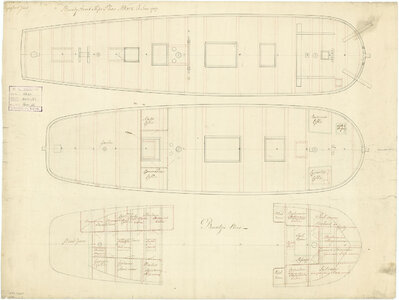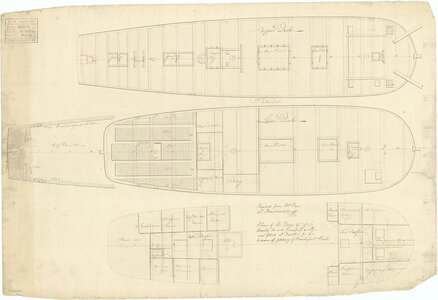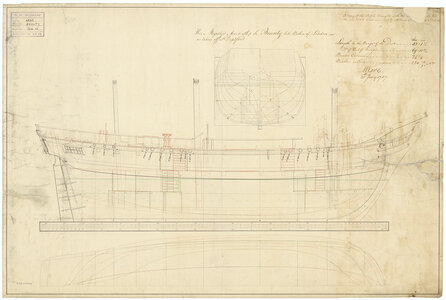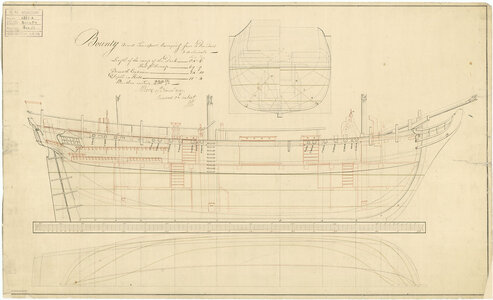I was looking at drawings and models of the Bounty and noticed that it had a capstan and a windlass. Didn't they serve the same function? Why would a ship have both?
-

Win a Free Custom Engraved Brass Coin!!!
As a way to introduce our brass coins to the community, we will raffle off a free coin during the month of August. Follow link ABOVE for instructions for entering.
You are using an out of date browser. It may not display this or other websites correctly.
You should upgrade or use an alternative browser.
You should upgrade or use an alternative browser.
I believe this is a drawing from the original ship and shows both. Not exactly sure of the purpose?


I tried to find that drawing with no luck. Sometimes the RMG and I just don't get along. 
Seems, that the Bounty had in the beginning only the windlass fore without the capstan

at this drawing the capstan is missing
 www.rmg.co.uk
www.rmg.co.uk
This drawing is showing than both - with installed capstan and changed hatches

The plan was received by the Navy Board on 20 November 1787.
 www.rmg.co.uk
www.rmg.co.uk


After her purchase at 23.05.1787 the Bounty received the capstan later on during the refit to be prepared to transport the plants - so they decided to need tha capstan purely to use for lifting actions (boats, loads, baskets etc.)
So I think the windlass for lifting anchor, the capstan for lifting everything else - the capstan was working much faster than a windlass
BTW:
the first drawing without the capstan is dated with 25. June 1787
the second drawing with the capstan is dated with 20. November 1787

at this drawing the capstan is missing
Bounty (purchased 1787) | Royal Museums Greenwich
This drawing is showing than both - with installed capstan and changed hatches

Bounty (1787)
Scale: 1:48. Plan showing the upper deck, lower deck and fore/aft platforms for HM Transport Bounty (1787), as fitted at Deptford Dockyard for transporting breadfruit plants.The plan was received by the Navy Board on 20 November 1787.
Bounty (purchased 1787) | Royal Museums Greenwich


After her purchase at 23.05.1787 the Bounty received the capstan later on during the refit to be prepared to transport the plants - so they decided to need tha capstan purely to use for lifting actions (boats, loads, baskets etc.)
British survey vessel 'Bounty' (1787)
British survey vessel 'Bounty' (1787). Dates of service, name changes, previous and next incarnations, dimensions, armament, commanders, officers and crewmen, actions, battles, sources
threedecks.org
So I think the windlass for lifting anchor, the capstan for lifting everything else - the capstan was working much faster than a windlass
BTW:
the first drawing without the capstan is dated with 25. June 1787
the second drawing with the capstan is dated with 20. November 1787
Thank you Uwe, that's interesting. Do you mind if I ask what did you use for search parameters? I searched for Bounty and Hms Bounty and came up with 0 results. I figured it had to be wrong but nothing.
I go directly to NMM and also three decksThank you Uwe, that's interesting. Do you mind if I ask what did you use for search parameters? I searched for Bounty and Hms Bounty and came up with 0 results. I figured it had to be wrong but nothing.
yes - usually, when I show a drawing from there I also add the link to this page
Thanks Uwe, I'll just have to keep poking away
In
to heave anchor in a hurry, they’d use the capstan, but also for everything else.
mainly boats, but also jeering up yards, resetting topmasts…
also note that on some of the top views above, what appears to be a windlass is just bitts.
So it is possible that it was the windlass that was added
indeed, the ratchet capstan is handy as it requires less manpower, but is extremely slow.Seems, that the Bounty had in the beginning only the windlass fore without the capstan
View attachment 365883
at this drawing the capstan is missing
Bounty (purchased 1787) | Royal Museums Greenwich
www.rmg.co.uk
This drawing is showing than both - with installed capstan and changed hatches
View attachment 365884
Bounty (1787)
Scale: 1:48. Plan showing the upper deck, lower deck and fore/aft platforms for HM Transport Bounty (1787), as fitted at Deptford Dockyard for transporting breadfruit plants.
The plan was received by the Navy Board on 20 November 1787.
Bounty (purchased 1787) | Royal Museums Greenwich
www.rmg.co.uk
View attachment 365885
View attachment 365887
After her purchase at 23.05.1787 the Bounty received the capstan later on during the refit to be prepared to transport the plants - so they decided to need tha capstan purely to use for lifting actions (boats, loads, baskets etc.)
British survey vessel 'Bounty' (1787)
British survey vessel 'Bounty' (1787). Dates of service, name changes, previous and next incarnations, dimensions, armament, commanders, officers and crewmen, actions, battles, sourcesthreedecks.org
So I think the windlass for lifting anchor, the capstan for lifting everything else - the capstan was working much faster than a windlass
BTW:
the first drawing without the capstan is dated with 25. June 1787
the second drawing with the capstan is dated with 20. November 1787
to heave anchor in a hurry, they’d use the capstan, but also for everything else.
mainly boats, but also jeering up yards, resetting topmasts…
also note that on some of the top views above, what appears to be a windlass is just bitts.
So it is possible that it was the windlass that was added




